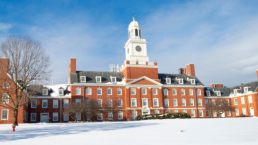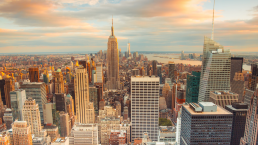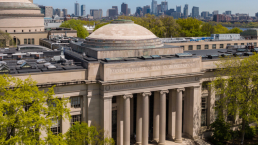Gustav Kjær Vad Nielsen, Yale University, 2019-2022
November 3 was my birthday. In the evening I celebrated the turn of my 26 years with my girlfriend and six friends at a local restaurant just down the street. We sat inside because the weather had turned chilly. Since a pandemic was raging, we were safely seated between large acrylic screens and were in turn allowed to dine without masks. While we were celebrating me, all of our minds were also on another event that evening of November 3rd 2020. And although only three anxious American citizens among us, the political event of the year thickened the air with angst and silent hopes as we indulged in cocktails and lobster bisque.
Studying at Yale with Fulbright
I have ventured to the USA to pursue a 3-year Masters of Architecture Degree at Yale University School of Architecture and the day of my birthday marks roughly the halfway of my planned stay. Born and raised in the suburbs of Copenhagen, Denmark, I have travelled far to find myself sitting here in my 60 sqm studio apartment located in Downtown New Haven, Connecticut from where I am writing this brief report of my experiences so far.
(Article continues under picture)
Fulbright Grants
Each year Fulbright Denmark awards grants to top Master and PhD-students wanting to study in the U.S.
Gurstav Kjær Vad Nielsen in front of Rudolph Hall in August 2019.
With a Bachelor of Arts in Architecture degree from Aarhus School of Architecture in Denmark and studies in sustainable urbanism at Delft University of Technology in the Netherlands I have come to Yale to learn about North American architecture and urban design, its ties to European traditions and current global influence.
Fulbright Denmark with IIE has provided me the support and guidance to navigate this adventure without too many concerns and the international network that comes with being a Fulbrighter has opened doors for me to follow through with my aspirations now and in the future.
(The article continues under picture)
A US Presidential Election Is A Big Deal
When I was awarded the Fulbright Grant and decided to go to the USA for my master’s degree, I knew that the presidential election would coincide with my stay but didn’t think much of it. Little did I know that only a few weeks later I would find myself reviewing the intricacies of the US voting systems and spit-balling potential democratic presidential candidates with fellow students at Yale. I recall especially one of the very first Friday bar events at the Yale School of Architecture – “6-on-7”. There, verbal arguments about the electoral college, Obama-care and visa-struggles were tossed back and forth across the roof top terrace on the 7th floor of Rudolph Hall – the School of Architecture building at Yale – as part of the heady mix of easily recognizable politely spoken introductory phrases and “stories of home” exchanged between students getting to know each other. It appeared to me how natural it was to discuss politics and wager political opinions to friends and strangers alike albeit at this point with a certain distance to the forthcoming election.
(The article continues under picture)
Roof top party on Rudolph Hall Roof Terrace in fall 2019.
Only in the early spring of 2020 did the political battle take front stage when the caucuses and primaries started narrowing down the field of candidates. Now a pandemic and social injustice protests were the main topics and neck on neck with black squares and Chinese pangolins, media broadcastings on established news channels and social media tracked candidates dropping out of the race one by one. Soon the front lawns of the New Haven houses flooded in signs endorsing their desired candidates. With the pandemic taking its hold, school transferred to Zoom and so did the political discussions that we used to have on the roof terrace at Rudolph Hall.
(Article continues under picture)
Blue Biden signs on the front lawn on Hillhouse Avenue in New Haven.
After returning to New Haven from my summer pandemic hideout back in Denmark I have travelled around Connecticut and Massachusetts by car and experienced how the colors of lawns change rapidly from blue [Democrats] to red [Republicans] as one leaves the city centers. A sign of sharp political divides between democratic cities and their republican hinterlands. I have followed the absurdities of the televised presidential debates and most recently seen Yale Campus covered with banners and posters reminding all American citizens to vote.
(Article continues under picture)
Vote sign in front of Yale’s Wooster Hall Downtown New Haven.
And Life Goes On
With the uncertainty that the ongoing election brings [this article was written before we knew the outcome], of which the outcome will have a global impact no doubt, I find comfort in the people around me and the experiences that I have right in front of me. Besides following classes in school and exploring New England, I have a few projects in the pipeline that brings stability to my present and future.
One such project is a research project called HOME WORK that studies the effects of the pandemic on the way we live and work. The project looks at historical and commercial precedents of the “home-office” as an architectural typology and social construct. But it also interrogates the current urgencies imposed by the pandemic, in an effort to understand what might be an appropriate response in the design of our homes and offices in the future. The project is led by me and three fellow graduate students and will culminate in an exhibition at Yale in Spring 2021 and a publication.
My stay at Yale had not been possible without the help and guidance of Fulbright Denmark and I can only recommend students to take the leap and experience the US through education at top universities and research institutions.
Photo from recent “Pop-Up Office” co-work space installation by HOME WORK at Yale North Gallery Fall 2020
Related
April 3, 2024
Toxic adfærd i online gaming – Rutgers University
Læs om Louise Anker Nexøs udlandsophold ved Rutgers University
March 15, 2024
Rytme og groove hos ensidigt døve – New York University
Læs om Alberte Baggesgaard Seebergs udlandsophold ved New York University
March 6, 2024
Kunstig Intelligens – Massachusetts Institute of Technology
Læs om Frederk Ørsted Kjeldals ophold ved Massachusetts Institute of Technology




